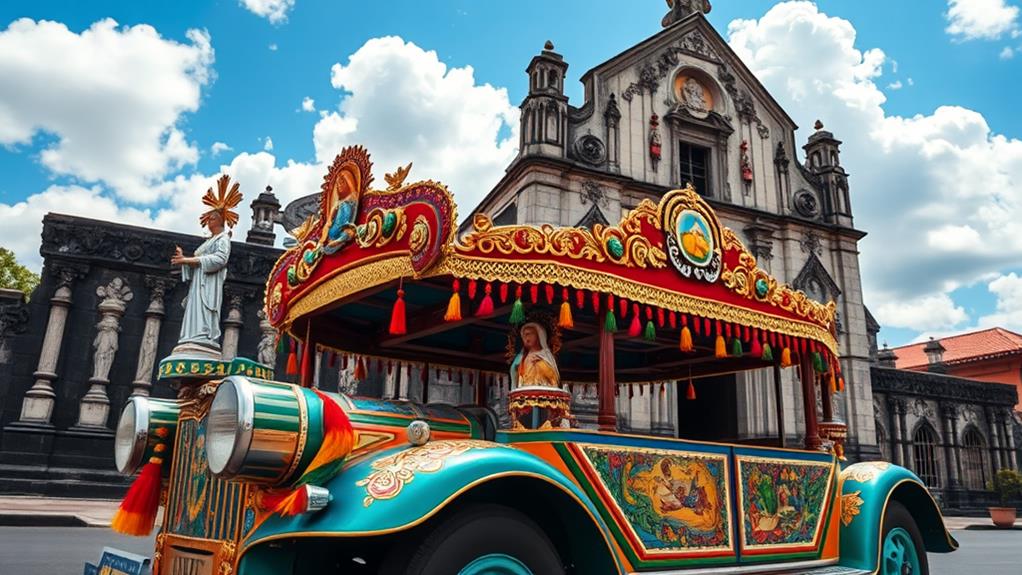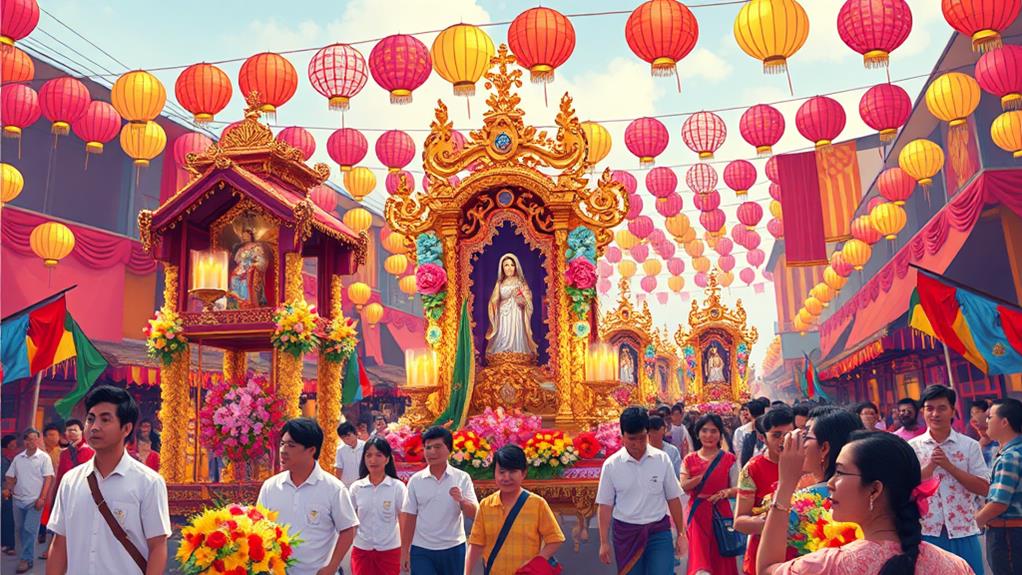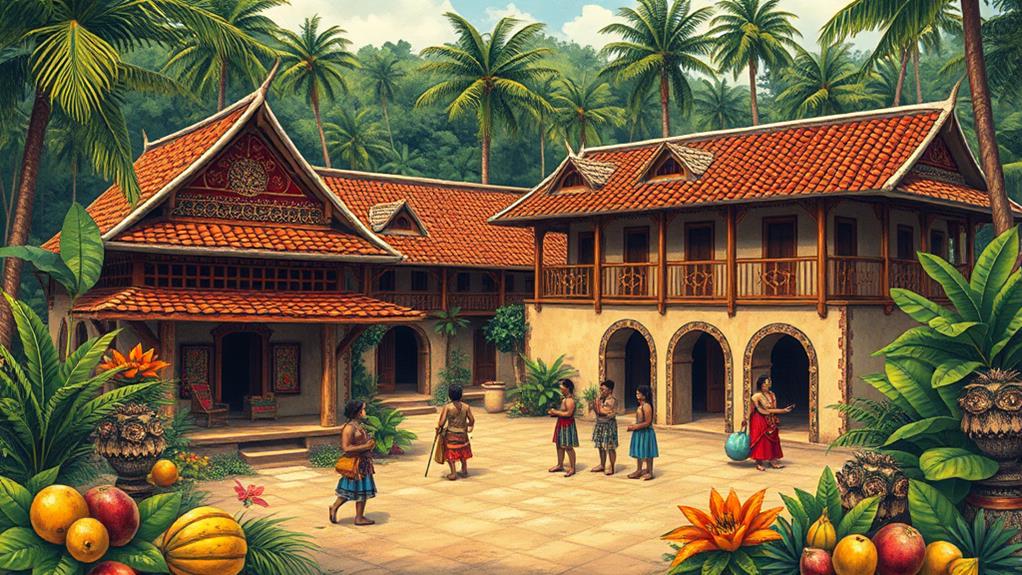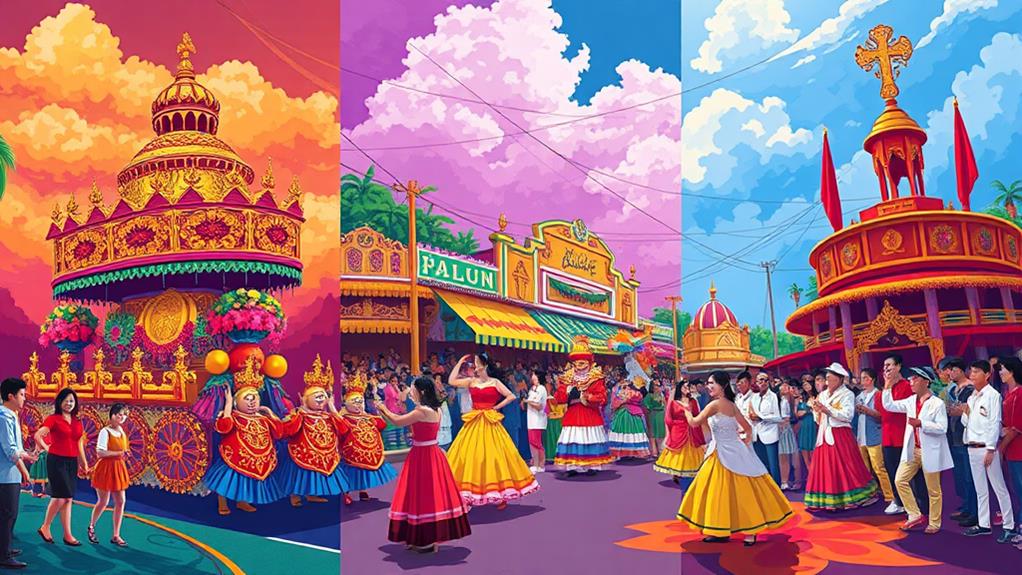Filipino Fiestas: A Celebration of Faith and Community
A Filipino fiesta is a vibrant celebration that showcases the country's rich cultural heritage.
At its core, a fiesta is a testament to the deep integration of Catholicism in Filipino traditions. These celebrations honor patron saints, highlighting the importance of faith in Filipino culture.
Fiestas also emphasize the significance of social ties and community participation. They bring people together, fostering a sense of belonging and cultural identity.
For example, during a fiesta, you'll often see streets filled with colorful parades, lively music, and traditional dances. These events encourage community involvement, with locals participating in the preparations and celebrations.
A fiesta is also a celebration of Filipino values and practices. It's an opportunity to experience the country's vibrant culture, with its rich flavors, sights, and sounds.
You'll find traditional Filipino cuisine, such as lechon and adobo, being served during the celebration. You'll also hear traditional music and see folk dances, like the tinikling, being performed.
In summary, a Filipino fiesta is a celebration that showcases the country's rich cultural heritage, emphasizing faith, community, and tradition.
It's a testament to the Filipino spirit, which values social ties, community participation, and cultural identity.
Faith and Cultural Heritage

Faith and Cultural Heritage in the Philippines
Your Filipino heritage is deeply rooted in your faith, which is predominantly Roman Catholicism. This connection is vibrantly showcased in the country's festive celebrations, known as fiestas.
Fiestas primarily honor patron saints, reflecting the profound influence of Roman Catholicism in Filipino culture and spirituality. For example, the Sinulog Fiesta celebrates Santo Niño and marks the introduction of Christianity to the Philippines in 1521, embodying hope, faith, and community love.
Through fiestas, you experience the rich cultural heritage of the Filipino people. Rituals like prayers, novenas, and processions highlight the significance of religious devotion and collective participation among community members.
These celebrations also serve as a means of cultural expression, showcasing traditional dances, music, and cuisine that celebrate shared heritage and values.
Many towns have unique fiestas that combine historical events with religious significance, illustrating the adaptation of pre-Hispanic traditions to align with Catholic teachings.
Celebrating Community Togetherness
Filipino fiestas are a celebration of community togetherness. At their core, these vibrant events bring people together, fostering stronger bonds and a spirit of unity.
Families open their doors and share food with guests, regardless of their personal resources, showcasing the warm hospitality of every Filipino community.
Weeks of collaboration among community members precede the festivities, with locals working together to prepare for the celebrations. During festivals like Sinulog and Ati-Atihan, collective activities like parades and traditional games bring people together, further strengthening communal ties.
Shared meals featuring signature dishes like adobo and lumpia serve as a central element in building relationships and celebrating cultural heritage.
Local organizations and volunteers work together to ensure successful celebrations and promote inclusivity, demonstrating community involvement at its best.
Through these moments, it becomes clear that Filipino fiestas are, indeed, a celebration of community togetherness.
Traditional Practices and Rituals

Traditional Practices and Rituals
Filipino communities take pride in preserving their vibrant traditions and rituals, rooted in faith and heritage.
Altar Adornments
In every Filipino home, altars are adorned with statues of saints, candles, and rosaries, reflecting faith in daily life and during fiestas. This practice highlights the importance of prayer and devotion, especially during fiesta celebrations centered around patron saints.
Panata
Panata involves making votive offerings, representing deep-rooted traditions tied to family and faith. This ritual emphasizes the significance of devotion and commitment to one's faith and community.
Community Rituals
Filipino communities come together through donations and volunteering, emphasizing the collective spirit of giving and support.
These community rituals foster a sense of unity and cooperation, showcasing the strong sense of faith and community that defines Filipino culture.
Food, Festivities, and Fun
Filipino Fiestas: A Celebration of Food, Community, and Joy
In the Philippines, fiestas are vibrant celebrations that delight the senses, with traditional cuisine playing a starring role. The aromas and flavors of Filipino dishes bring people together, fostering a sense of community and togetherness.
Traditional Filipino cuisine is a highlight of fiesta celebrations. Dishes like adobo, kare-kare, and lumpia are staples that unite people across generations. These dishes are often prepared with love and care by family members and friends, symbolizing the community spirit at the heart of every Filipino fiesta.
Fiestas are also a time for entertainment and friendly competition. Karaoke sessions often turn into impromptu dance parties, while games and contests showcase local talents and bring out the competitive spirit in everyone.
Food is more than just something to eat; it's a way to bond with others and strengthen community ties. In every Filipino community, fiestas are a time to come together, celebrate, and create unforgettable memories.
A Glimpse Into Filipino History

Filipino fiestas have a rich history that dates back to the Spanish colonial period.
The history of Filipino fiestas originated from Spanish colonial influences, where missionaries adapted local customs to celebrate Roman Catholic feasts, particularly events in the lives of Jesus and Mary. For example, the Fiesta de Santo Niño honors the Infant Jesus and symbolizes the beginning of Christianity in the Philippines.
Some Filipino fiestas, however, have pre-Hispanic roots. The Sinulog and Ati-Atihan festivals, for instance, originated from pre-Hispanic rituals. The Sinulog celebrates the Santo Niño (Infant Jesus) and honors the country's patron saint, while the Ati-Atihan commemorates the arrival of Malay settlers in the Philippines.
Over time, Filipino fiestas have integrated elements from both indigenous practices and colonial influences, creating a unique cultural tapestry.
A significant event that contributed to this blend of cultures is the gifting of the Santo Niño statue by King Philip of Spain to the Queen of Cebu. This integration has fostered community spirit and identity, making Filipino fiestas an essential part of the country's cultural heritage.
Embracing Cultural Diversity
Filipino fiestas showcase the country's rich cultural heritage, where diverse traditions and customs blend in vibrant celebration.
Each region has a unique identity shaped by its individual history and cultural practices, which you can experience through these festivities.
Festivals reflect the country's pre-Hispanic and Spanish colonial influences. For example, Sinulog and Ati-Atihan blend local customs with Roman Catholic traditions.
The Filipino Fiesta of Sacramento, held every January, celebrates Filipino American heritage and brings together diverse cultural organizations.
Through these celebrations, different cultural groups come together, sharing their traditions and fostering a sense of belonging and cultural pride among attendees.
Fiestas Across the Philippines

The Philippines is a country with a rich cultural heritage, and its numerous fiestas are a testament to this. Over 100 fiestas take place annually, each unique to its region. These vibrant celebrations primarily honor the patron saint of each city or province.
Major fiestas like Sinulog in Cebu, Ati-Atihan in Aklan, and Pahiyas in Lucban showcase a blend of religious devotion and cultural heritage. These events attract thousands of attendees and feature parades, traditional dances, and communal feasting, reflecting the strong emphasis on community and togetherness in Filipino culture.
Many fiestas have historical roots dating back to Spanish colonial influence, adapting indigenous practices to incorporate Christian elements.
These fiestas bring people together and contribute to local economies through tourism and community participation, promoting local artists and businesses.
How Does the Sinulog Festival Differ from other Filipino Fiesta Celebrations?
The Sinulog Festival stands out from other Filipino fiesta celebrations due to its vibrant and energetic atmosphere. This grand festival of cebu features a unique dance ritual that honors the Santo Niño, setting it apart from the traditional religious processions and cultural performances typically seen in other fiestas across the Philippines.
Passing on Cherished Values
Fiestas: Preserving Filipino Culture and Values
Beyond the vibrant colors and lively rhythms of the Philippines' numerous fiestas lies a deeper purpose: to pass on cherished values from one generation to the next. These celebrations play a significant role in promoting and preserving Filipino culture.
Fiestas Emphasize Faith, Community Bonds, and Hospitality
Fiestas often involve rituals and traditions that have been passed down through generations, such as panata (votive offerings) and the communal preparation and sharing of traditional dishes like adobo and lumpia. These practices highlight the importance of faith, community bonds, and hospitality.
Key Aspects of Fiestas
Events like the Sinulog Fiesta honor religious figures and serve as opportunities for families to come together and pass on cultural heritage to younger generations.
Involvement in community activities, such as volunteering and participating in parades, fosters a sense of belonging and reinforces shared cultural values among attendees.
The engagement of diverse cultural groups promotes collaboration and understanding while preserving Filipino traditions and spiritual beliefs.
Frequently Asked Questions
What Is Fiesta Celebration in the Philippines?
Fiesta celebrations in the Philippines are rooted in cultural heritage and honor patron saints. These events reflect the country's Roman Catholic faith and rich cultural traditions.
For instance, the Feast of Santo Niño in Cebu City is a significant fiesta that commemorates the arrival of Spanish conquistador Ferdinand Magellan in 1521. This celebration showcases colorful parades, traditional dances, and delicious local food, highlighting the country's cultural identity.
Fiestas foster a sense of community and togetherness. During these celebrations, Filipino communities come together to socialize, share food, and participate in various activities.
For example, the MassKara Festival in Bacolod City is a popular fiesta that features vibrant street dances, costumes, and masks, promoting unity and camaraderie among residents and visitors alike.
What Is the Importance to Our Society of the Fiesta Philippines Celebration of Patrons?
Fiesta Philippines celebrations of patrons play a vital role in maintaining cultural unity. By honoring patron saints, these festivities reinforce community bonds, collective devotion, and a sense of belonging.
They foster social cohesion, allowing individuals to express gratitude, seek blessings, and strengthen relationships.
For example, in Filipino diaspora communities, these celebrations help maintain cultural continuity by bridging gaps and nurturing a deeper connection with heritage.
What Is the Objective of Fiesta Celebration?
The objective of fiesta celebrations is to honor patron saints and showcase cultural heritage.
These vibrant events pay homage to faith and celebrate a community's unique identity, traditions, and values. By participating in fiestas, people actively preserve their cultural legacy, ensuring its continuity for future generations.
For instance, in Mexico, the Fiesta de la Vendimia honors the patron saint of grape harvesters, while in the Philippines, the MassKara Festival celebrates the city's patron saint and showcases the local culture.
Why Do Catholics Celebrate Fiesta?
Catholics celebrate fiestas to express their deep-rooted faith and cultural heritage.
These vibrant events allow them to honor their patron saints, paying tribute to their community's history and strengthening their spiritual bonds.
Fiestas serve as a time for reflection, gratitude, and renewal of faith, bringing families together in celebration of their shared cultural heritage.